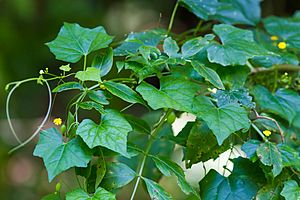Creeping cucumber facts for kids
Quick facts for kids Creeping cucumber |
|
|---|---|
 |
|
| Scientific classification | |
| Genus: |
Melothria
|
| Species: |
pendula
|
The creeping cucumber, also known as the Guadeloupe cucumber, is a fascinating plant. Its scientific name is Melothria pendula. This plant is often found in the southeastern parts of the United States. It looks a lot like the cucumbers we eat, but it's much smaller! It has tiny yellow flowers and leaves that look similar to regular cucumber plants. Even its growth patterns are alike. The young fruits look like tiny watermelons.
Contents
What's in a Name?
The name Melothria comes from an old Greek word. It means 'kind of white grape'. This name was given because the plant grows small fruits, much like tiny grapes. The second part of its scientific name, pendula, is Latin. It simply means 'hanging'. This describes how the fruits hang from the plant.
Is it Safe to Eat?
The ripe fruits of the creeping cucumber are black. If you eat these black fruits, they can act as a strong laxative. This means they can make you go to the bathroom a lot! We don't know much about how safe the roots, vines, leaves, and flowers are to eat.
Eating the Creeping Cucumber
You can eat the fruits of the creeping cucumber when they are unripe. At this stage, they are light green. You can even eat them raw! Some dogs have been seen eating the leaves of this plant. They didn't seem to have any problems after eating them.
Who Eats the Creeping Cucumber?
Some insects like to eat the creeping cucumber. The young forms, called larvae, of a moth named Hypercompe cunigunda have been seen feeding on this plant.
See also
 In Spanish: Pepino rastrero para niños
In Spanish: Pepino rastrero para niños


